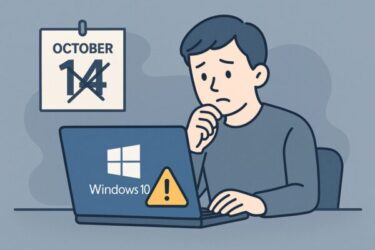- 1 Introduction: “Not Now, Windows…”
- 2 1. The Hard Truth: You Can’t Completely Turn Windows Update Off
- 3 2. Why Windows Still Updates in the Background (Even With Active Hours)
- 4 3. The Role of Windows Update Medic Service: Why “Disabling” Doesn’t Stick
- 5 4. Driver Updates: The “Hidden” Source of Freezes and Stutters
- 6 5. What’s Actually Happening When Your PC Goes 100% Disk and CPU
- 7 6. Why “Completely Disabling” Windows Update Is a Bad Idea
- 8 7. Realistic Ways to Reduce Freezes and Interruptions (Without Breaking Your System)
- 8.1 7.1 Use “Pause updates” before critical work periods
- 8.2 7.2 Plan around “Patch Tuesday” and heavy update days
- 8.3 7.3 Set Active hours to match your real schedule
- 8.4 7.4 Use a metered connection to slow down automatic downloads
- 8.5 7.5 Let updates install when you decide (pre-update before busy days)
- 8.6 7.6 Tame driver updates (especially for GPU and network)
- 8.7 7.7 Unplug external drives and USB devices during long work sessions
- 9 8. What to Do If Your PC Freezes During an Update
- 10 9. FAQ: Common Questions About Forced Updates
- 11 10. Key Takeaways: How to Live With Windows Update (Without Going Crazy)
Introduction: “Not Now, Windows…”
You sit down with a cup of coffee, ready to focus.
Then suddenly:
- Your laptop fan roars at full speed
- The mouse starts lagging or freezing
- The disk light stays lit, and apps respond in slow motion
You open Task Manager and see high CPU and 100% disk usage, with “Windows Update”–related processes at the top.
“But I set updates to manual.”
“I even configured Active hours. Why is Windows updating now?”
If that sounds familiar, you’re not alone. Around the world, Windows users ask questions like:
- “Why does Windows Update still run automatically?”
- “Why is my PC freezing during work because of updates?”
- “How do I stop forced updates without breaking my system?”
In this guide, we’ll walk through:
- Why Windows 10/11 can still update even if you use manual settings or Active hours
- What’s actually happening in the background when your PC suddenly becomes slow or unresponsive
- Why completely disabling Windows Update is risky
- Practical, realistic ways to reduce freezes and interruptions without sacrificing security
This isn’t about hacking the registry or using shady “disable update forever” tools.

Instead, we’ll focus on safe, supportable methods that help you stay secure and keep your PC usable.
1. The Hard Truth: You Can’t Completely Turn Windows Update Off
Let’s start with the uncomfortable reality:
Windows 10 and Windows 11 are not designed to let you fully disable updates.
In home and small business environments, Windows Update is built around the idea of:
- Automatically installing security patches
- Keeping system components and servicing stack up to date
- Applying fixes that reduce compatibility and reliability issues over time
From Microsoft’s point of view, leaving large numbers of PCs unpatched is a serious security risk.
That’s why certain classes of updates can override your preferences.
Types of updates that may ignore your “manual” expectations
Even if you “set updates to manual” or try to control them tightly, Windows may still push:
- Critical security updates (especially zero-day vulnerabilities)
- Servicing Stack Updates (SSU) – the core plumbing that lets Windows install other updates
- Update stack / component updates that keep Windows Update itself functioning correctly
- Sometimes driver updates, particularly for graphics or networking
So if you’ve ever wondered:
“I’m sure I set this to manual, why is it still doing something?”
…it’s not your imagination.
Certain updates can and do bypass your preferred rhythm in order to keep the system within Microsoft’s supported and secure baseline.
2. Why Windows Still Updates in the Background (Even With Active Hours)
Another common misunderstanding revolves around Active hours.
Many people assume:
“If I set Active hours, Windows won’t touch anything during that time.”
Unfortunately, that’s not how it works.
Active hours only control when Windows is allowed to restart automatically
Active hours mainly tell Windows:
“Please don’t reboot the PC automatically during this time window.”
What Active hours does not do:
- It does not stop Windows from downloading updates
- It does not fully prevent background installation and preparation
- It does not guarantee “no update activity” while you’re working
This means:
- You might avoid sudden restarts during your workday
- But you can still experience heavy background activity – downloads, file unpacking, optimization – while you’re using the PC
If you’ve ever felt your system crawl and later noticed “Updates were installed,”
you probably hit that background preparation phase.
3. The Role of Windows Update Medic Service: Why “Disabling” Doesn’t Stick
If you’ve searched the web for “how to disable Windows Update,” you’ve probably seen suggestions like:
- Stop the Windows Update service
- Set the service to Disabled
- Use third-party tools that claim to “turn off updates forever”
The problem is that modern Windows versions include a watchdog process called:
Windows Update Medic Service (WaaSMedicSvc)
Its job is:
- To detect when Windows Update components are “broken”
- To repair or re-enable update services that have been manually disabled
So even if you:
- Disable
wuauserv - Change certain registry keys
- Use a tool that flips services off
WaaSMedic can come along later and say:
“Something seems wrong with the update system. I’ll fix that for you.”
…and your attempt to disable updates is silently undone.
That’s why so many users complain:
“I disabled Windows Update service, but it came back on its own.”
It’s not a bug — it’s by design.
4. Driver Updates: The “Hidden” Source of Freezes and Stutters
Another piece of the puzzle: drivers.
Your PC relies on drivers for:
- Graphics (GPU)
- Network (Wi-Fi / Ethernet)
- Audio
- Storage controllers and more
In many cases, driver updates are delivered through Windows Update.
In others, they may come from:
- OEM utilities (Dell, HP, Lenovo, etc.)
- GPU vendor tools (NVIDIA GeForce Experience, AMD Adrenalin, Intel Arc/Driver & Support Assistant)
Why driver updates can make your PC freeze
During a driver update, Windows may:
- Unload and reload critical components (e.g., graphics or network stack)
- Reconfigure services and kernel-level modules
Symptoms you might see:
- Screen goes black briefly, then comes back
- Apps stop responding or redraw slowly
- Mouse and keyboard feel laggy
- Network suddenly drops and reconnects
Sometimes, particularly with graphics drivers, the system can appear completely frozen for a while.
So even if you think:
“I disabled Windows Update, so nothing should be installing”
you may still have driver update mechanisms firing in the background and causing stutters.
5. What’s Actually Happening When Your PC Goes 100% Disk and CPU
Let’s connect this to what you see in Task Manager.
When updates are being prepared in the background, you might notice processes like:
- Windows Modules Installer (TrustedInstaller.exe)
- Windows Update related services
.NEToptimization services (ngen)- Antivirus/defender scanning updated files
Behind the scenes, Windows may be:
- Unpacking large update packages
- Generating and applying delta patches
- Optimizing .NET assemblies
- Updating system components, recovery environment files, etc.
All of that means:
- High disk I/O
- High CPU usage
- More heat → fan ramps up
- Your apps respond slowly or stop responding for moments
This is why it feels like:
“My PC suddenly decided to do something heavy right now.”
6. Why “Completely Disabling” Windows Update Is a Bad Idea
Given all this, it’s tempting to say:
“Fine. I’ll just disable it completely. Problem solved.”
But that creates bigger problems down the road.
Risks of fully disabling updates
- Security vulnerabilities stay unpatched
- You miss critical and zero-day patches
- Your system could be compromised via known, fixed flaws
- Compatibility issues accumulate
- New apps or games might expect certain updates
- Drivers and OS components can fall out of sync
- Future feature updates become more painful
- The longer you stay unpatched, the bigger the gap
- When you finally update, the system needs to jump many versions and patches at once → more risk of failure
- WaaSMedic & other components may fight your changes
- You enter a “tug-of-war” where Windows keeps trying to “fix” what you intentionally disabled
- That can lead to more instability, not less
In short:
Trying to “kill” Windows Update completely is like pulling out the brakes and airbags to make your car lighter.
You might feel faster at first… until something goes wrong.
A better approach is to control and schedule updates, not to pretend they don’t exist.
7. Realistic Ways to Reduce Freezes and Interruptions (Without Breaking Your System)
Now the part you actually care about:
“What can I do so updates don’t keep hijacking my work sessions?”
Below are practical methods that significantly reduce interruptions and freezes, while keeping your system reasonably secure.
7.1 Use “Pause updates” before critical work periods
For many users, Pause updates is the single most effective tool.
On Windows 10/11:
- Open Settings → Windows Update
- Click Pause updates for 1 week
- If needed, click again to extend (you can chain a few weeks, depending on version)
This prevents regular quality and feature updates from:
- Being downloaded
- Being installed silently in the background
You can use this before:
- Important deadlines
- Live streams / presentations
- Video calls and online exams
- Any period where you need maximum stability
⚠ Short safety note
Pausing is safe and supported, but:
- Don’t leave updates paused indefinitely
- After your critical work is done, go back to Resume and let the system catch up
Think of pause as “airplane mode for updates,” not a permanent off switch.
7.2 Plan around “Patch Tuesday” and heavy update days
Microsoft’s major monthly release is commonly called Patch Tuesday:
- Officially: the second Tuesday of each month
- Practically: updates roll out over the following days (depending on time zones and settings)
On these days, Windows is more likely to download and install large updates.
Good habits:
- Avoid scheduling mission-critical tasks on those days if possible
- If you must work heavily that day, consider using Pause updates in advance
- Apply updates on your schedule (e.g., in the evening or weekends) and reboot before your next deep-work session
Knowing when the “storm” usually hits makes it easier to work around it.
7.3 Set Active hours to match your real schedule
Even though Active hours doesn’t stop all background activity, it still helps by:
- Preventing surprise automatic restarts while you’re working
- Encouraging Windows to complete restarts when you’re not using the PC
Tips:
- Set Active hours to cover your typical full working day (Windows can auto-adjust based on usage, or you can set it manually up to a long window)
- If you often work late, extend Active hours into the evening
- Use manual restarts after you know an update is ready, so you stay in control
7.4 Use a metered connection to slow down automatic downloads
On Wi-Fi, you can mark a network as metered, which tells Windows:
“Please be more conservative with data. Don’t download everything automatically.”
How:
- Go to Settings → Network & Internet → Wi-Fi
- Click your connected network
- Turn on Metered connection (wording may vary slightly)
Effects:
- Large updates and some feature updates will not download automatically
- Windows will usually wait for you to manually trigger updates or connect to a non-metered network
Limitations:
- Critical security patches may still be downloaded
- Not all background activity stops
But in practice, this significantly reduces the “surprise download and freeze” scenarios.
7.5 Let updates install when you decide (pre-update before busy days)
One of the simplest but most effective habits:
Before a busy period, let Windows fully update and reboot on a day/time you choose.
For example:
- On a Friday evening or weekend:
- Open Settings → Windows Update
- Click Check for updates
- Let it download & install
- Restart the PC once or twice until there are no more pending updates
Then on Monday morning, you start with:
- A fully updated system
- Very little chance of huge updates being prepared in the background that day
It’s like doing your chores early, so they don’t interrupt you later.
7.6 Tame driver updates (especially for GPU and network)
Because drivers can seriously affect stability, it’s worth putting extra thought into them.
On Windows 10/11 Pro
If you’re comfortable with Group Policy, you can:
- Limit automatic driver installs from Windows Update
- Configure device installation restrictions for specific hardware
This can reduce unexpected driver changes that cause freezes.
On Home editions and for most users
A safer pattern is:
- Let your PC or GPU manufacturer’s tools handle driver updates (Dell/HP/Lenovo utilities, GeForce Experience, AMD/Intel tools)
- Disable or be cautious with “optional driver updates” via Windows Update, unless they fix a known issue you actually have
The goal is not “never update drivers,”
but “update them on your terms, at your chosen time.”
7.7 Unplug external drives and USB devices during long work sessions
This sounds minor but can matter more than you think.
If you leave:
- External HDD/SSD
- USB sticks
- SD cards
connected all the time, Windows might:
- Scan or index them
- Touch them during update-related checks
- Trigger additional I/O during backup or maintenance tasks
During heavy update activity, that extra I/O can push your disk usage over the edge.
Habits that help:
- Disconnect external drives when you don’t actually need them
- Only plug them in for backups, file transfers, or specific tasks
Less I/O = fewer chances for “my system just froze for 30 seconds.”
8. What to Do If Your PC Freezes During an Update
Even with all precautions, it’s still possible to get caught in a bad moment.
Here’s what to do (and what not to do).
8.1 Don’t hard-power off immediately if you see update messages
If you see:
- “Working on updates”
- “Installing updates XX%”
- “Do not turn off your computer”
and the system seems stuck:
- Give it time – sometimes “stuck at 30%” is actually doing heavy work
- For laptops, plug in the power adapter
Hard shutdowns during critical update phases can:
- Corrupt system files
- Leave you in a boot loop or recovery environment
- Cause more time-consuming repair work later
8.2 Use Task Manager to confirm what’s happening (when possible)
If the system is very slow but not totally frozen:
- Press Ctrl + Shift + Esc to open Task Manager
- Check the Performance tab → CPU / Disk usage
- On Processes, see if Windows Modules Installer, Windows Update, or similar processes are at the top
If you confirm “yes, this is update activity”:
- Save your work if you can
- Let Windows finish what it’s doing
- Afterwards, consider applying some of the preventive tips from this guide
9. FAQ: Common Questions About Forced Updates
Q1. Can I completely stop Windows Update forever?
Realistically: Not in a safe and supported way.
Any hack that claims to:
- Permanently disable updates
- Prevent all patches from ever installing
either:
- Leaves you exposed to security threats
- Risks future instability
- May be undone by Windows itself (via WaaSMedic and related components)
Q2. Is it safe to use third-party “Disable Windows Update” tools?
In general, I don’t recommend it.
Problems include:
- They often rely on undocumented tricks that break with future updates
- They may interfere with other components (e.g., Store, Defender, .NET updates)
- You usually don’t know exactly what they changed — making future troubleshooting harder
If you care about reliability, it’s better to:
- Use built-in tools (Pause, Active hours, metered connection)
- Use Group Policy on Pro/Enterprise if you know what you’re doing
Q3. Are forced updates only a Windows 10/11 problem?
Earlier versions of Windows had update issues too, but:
- Windows 10 introduced the “Windows as a Service” model
- Windows 11 continues that design
So yes, this behavior is most strongly associated with Windows 10 and 11.
On the other hand, they also receive more frequent security and stability improvements.
10. Key Takeaways: How to Live With Windows Update (Without Going Crazy)
Let’s wrap it up.
1. It’s not your fault.
If Windows updates run even with manual settings or Active hours, it’s mostly due to design & security priorities, not user error.
2. Some updates will always have priority.
Critical patches, servicing stack updates, and some driver updates can override your preferences.
3. Completely killing updates is a bad long-term strategy.
You’ll trade short-term convenience for long-term risk and instability.
4. The goal is control, not denial.
Use:
- Pause updates before important work
- Plan around Patch Tuesday
- Set Active hours realistically
- Use metered connections to slow down automatic downloads
- Let Windows fully update on your schedule (pre-update before busy days)
- Be thoughtful about driver updates
- Unplug unnecessary external drives during long sessions
Together, these steps can significantly reduce:
- Surprise freezes
- “Fan jet engine” moments
- Annoying slowdowns during your work
You don’t have to love Windows Update.
But with the right strategy, you and your PC can co-exist peacefully —
updated, secure, and still usable when you need it most.
💡 Looking for more tips? Check out our full list of Windows Help Guides.


